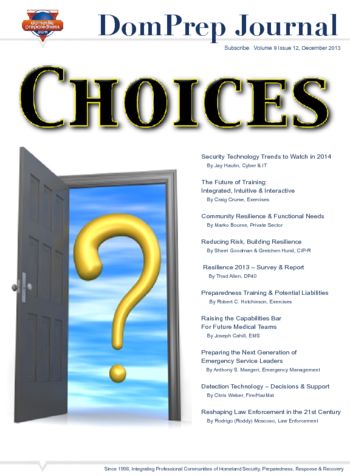

Preparing the Next Generation of Emergency Service Leaders
Anthony S. Mangeri
December 25, 2013
In a world where disasters and other emergency incidents occur every day, emergency service leaders are responsible for bringing calm and structure in the midst of crisis. Some of these leaders will begin this path as early as high school, while others will migrate to the emergency services as their roles and responsibilities change.

FINAL REPORT: Resilience 2013
Thad W. Allen
December 23, 2013
On 18 November 2013, DomPrep hosted an executive briefing at The National Press Club to present the
Resilience 2013 – Survey & Report. The survey outlined in this report is the second of a series that
Booz Allen Hamilton has partnered on with DomPrep Journal. The survey drills down into policy challenges
for federal programs and understanding impacts at the state and local levels, where the majority of the
resilience effort is realized.

Security Technology Trends to Watch in 2014
Jay Hauhn
December 18, 2013
As security needs continue to change, the technology to meet those needs also must constantly evolve. In 2014, five key technology trends may change the way that business managers protect their employees, data, and facilities: cloud services, wireless technologies, standards, distance biometrics, and business intelligence.

The Future of Training: Integrated, Intuitive & Interactive
Craig Crume
December 18, 2013
Different people have different learning styles; therefore, an effective training process must be able to meet those individual needs in order to improve information retention, resolve issues, and promote an ongoing learning experience. As equipment evolves, so too must the training. Otherwise, that shiny new equipment may simply gather dust.

Reshaping Law Enforcement in the 21st Century
Rodrigo (Roddy) Moscoso
December 17, 2013
New technologies and response equipment – combined with social media and mobile applications – are changing the way law enforcement agencies protect themselves and their communities. What were once only possible in science-fiction movies are increasingly growing in use within law enforcement communities across the nation – drones, facial recognition, and instant data access and analysis.

FINAL REPORT: Food Defense
Amy Kircher
December 13, 2013
Food, like water and air, is essential to sustain life. As such, when someone deliberately taints that sustenance at any point in the food supply chain, the result can be devastating. This report addresses the topic of food defense, which is of great importance to the preparedness community, but it often is not widely understood, especially outside the food and agriculture sector.

Detection Technology – Decisions & Support
Chris Weber
December 11, 2013
New technologies and equipment mean new training concerns. Ensuring that responders are capable of choosing the right equipment for an incident, knowing how to use it, and accurately interpreting the results are regular challenges for first responders and hazardous materials teams. To address these challenges, experts offer multi-technology support.

Preparedness Training & Potential Liabilities
Robert C. Hutchinson
December 11, 2013
Preparing for any disaster is essential for an effective incident response. However, by failing to properly prepare and train employees, agencies also are more vulnerable to potential liabilities. Past legal cases and court rulings highlight the consequences that agencies have faced as a result of inadequate training practices. Reduced funding may not an acceptable excuse.

Community Resilience & Functional Needs
Marko Bourne
December 10, 2013
On 7 November 2013, U.S. District Judge Jesse Furman ruled that: (a) New York City’s emergency planning inadequately accommodates people with disabilities; and (b) the city is in violation of local and federal laws, including the Americans with Disabilities Act. In his ruling, Furman said that the city’s current plans do not ensure the evacuation of people with disabilities, do not provide sufficiently accessible shelters, and do not do enough in general to inform all citizens about the emergency services available. He issued the ruling in response to a -action lawsuit initiated by disability advocacy groups following Tropical Storm Irene in 2011 – nearly two years before the devastation that Superstorm Sandy inflicted on the city and its residents in 2012.

Raising the Capabilities Bar for Future Medical Teams
Joseph Cahill
December 4, 2013
Predicting the future of emergency medical services (EMS) is often a frustrating task; but it also can be extremely rewarding. For many years, EMS leaders have been predicting a day when paramedics will be able to treat patients on-site – without having to transport them to a hospital or other healthcare facility. In fact, the so-called “Community Paramedic” has been just over the horizon since the mid-1980s.

